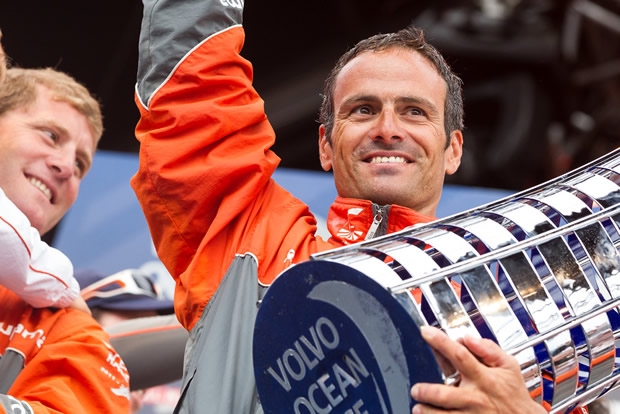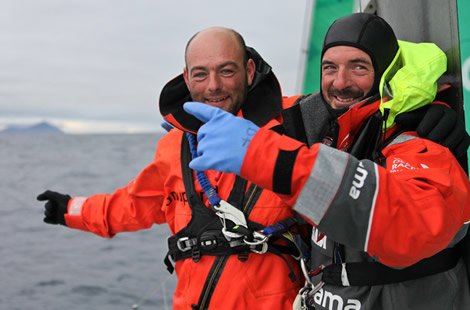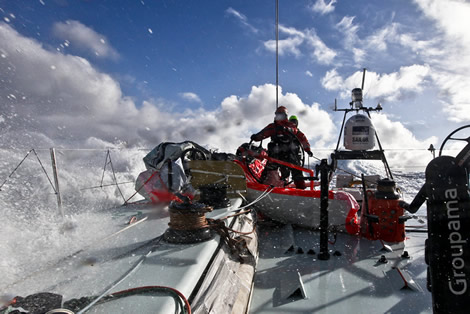
How Groupama won the Volvo Ocean Race
This Volvo Ocean Race confirmed some myths about the Volvo Ocean Race and dispelled others.
The victors, Groupama, continued the tradition of the winning team acquiring the previous winning boat, in this case Ericsson 4. However this time the first boat into Cape Town did not end up winning the race overall and, for the first time since Yamaha II overhauled Tokio after the latter dismasted during the Volvo 60s’ first outing in 1993/4, there was a mid-race change of leader. In fact, if you just look at the big boat class (when the race had more than one class), Flyer II in 1981 was the last boat to win overall without having been first into Cape Town (courtesy of Lizzie Ward).
The 2011-12 Volvo Ocean Race was also very strange in that all of the boats were at some point hampered by significant technical issues that cost them points. In fact you could argue that the overall results were ultimately determined on how much boats broke – whether it was Groupama or Puma’s dismastings, Camper’s mid-Pacific structural issue or Telefonica’s rudder breakages. Groupama can be excluded from this because her dismasting cost her 15 points into Itajai, but she went on to win overall by 22 points.
The return of the French
Groupama was something of an unknown going into this Volvo Ocean Race. It was the first time a French team had entered the race since La Poste in 1993-4 and there were rumours of sparks flying within the team as the Anglo-Saxon world of the fully crewed round the world race clashed with French offshore racing culture. The green boat also didn’t have the powerhouse crew of Volvo Ocean Race veterans like all of her competitors, with one third of her crew having never competed before and only Damian Foxall having competed in more than one race previously. Yes, Franck Cammas’ team had the biggest budget at 17 million Euros/year for the duration of the three year campaign, but there have been plenty of examples of major yacht races having not been won by the richest team.
Franck Cammas says that within the team they were not overly confident when they first pitched up prior to the start, but their confidence and knowledge grew dramatically over the course of the race. “We didn’t know the level we had in Alicante when we arrived there and after some races there we were not so happy with our level and our performance. We were confident with the performance of the boat and that was a good point. We made some mistakes, because it was the first entry for us and we had to learn - we had only raced in the Rolex Fastnet Race before and it was very short. So perhaps we didn’t race enough during two years with the team and maybe that was a mistake. We should have raced in other classes to improve our crew work.”
Up and away
On the first leg coming out of the Strait of Gibraltar they made what Cammas agrees was a major error, in following their instinct rather than the fleet, taking a route that hugged the West African coast rather than heading offshore. As a result they ended up losing majorly, although they still arrived third into Cape Town as Puma, Abu Dhabi Ocean Racing and Sanya were all beset by technical problems that prevented them from finishing.
Learning their lesson, on leg two they stuck with the fleet until bored of trying to batter their way through a trough in the Southern Ocean they split south, a tactical move that put them into first place, losing out subsequently in the Doldrums.
“We lost some time in the two first legs as we became confident with each other and with the boat’s performance as well,” says Cammas. “Then we finished first into Abu Dhabi - that was a good step being first for the first time and the second big step was into Auckland [their first leg win]. We lost the rig after Cape Horn and that stopped our progress, but we were more and more confident between ourselves and the fleet and getting on the podium more and more easily during the offshores, so we were definitely on the slope up.”
After Itajai, Groupama’s performance was a fine example of consistency, her only subsequent leg win being into Lorient after Telefonica suffered her rudder breakages, but otherwise always finishing on the podium.
They also managed to find the right balance being sailing their own race and sailing tactically against the fleet, important as the race is scored on points rather than on elapsed time. However Cammas advises: “It is good to be independent in the head. Other boats like Puma [went off on a flier] in the third and fourth legs. I think you do have to do that with these boats because they are very fast, like a multihull, you have to take risks very early because even with 5 knots of wind you can have 8 knots of boat speed, so it is important to be in a good spot.”
Three races on and they're still different
It strikes us as odd that despite all the teams using presumably similar global weather data from the last 20 years in developing the design of their boats, that they should end up in such different places with their moding. For example Telefonica was geared up for upwind and light reaching conditions and this proved exceptional on the first few legs of the race, resulting in the Spanish team’s commanding lead early on. In comparison Groupama has her keel 0.4m further aft than the two other Juan K designs and has also her rig heavily raked aft, and she is generally a weapon in brisk reaching conditions. She demonstated this, leading the boats through the Southern Ocean on leg five until she dismasted off the Uruguayan coast. So if the first half of the race suited the Spanish VO70, pretty much from Sanya on, conditions better suited the French boat both statistically and in reality.
“We pushed the reaching more, but it was in consultation with the designers and when we ran this boat around the world using the weather statistics for the last 20 years it was faster. But the first three legs of this race we had more upwind than expected. We were not lucky with that,” says Cammas as to why they chose their reaching weapon.
Over the course of the race all the teams improved, Telefonica perhaps the least. In Groupama’s case, their weak points were initially upwind and in light conditions, which Cammas says they largely tackled by introducing new sail shapes and revisiting the trim of the boat, in particular fore and aft weight distribution.
Laurent Pages, Groupama’s in-port tactician, offshore helmsman/trimmer and sail program co-ordinator, points out that while Puma was a very rounded boat in all conditions and Camper has a different set-up - more optimised for VMG work, weaker beam reaching - such was the progress of the leading teams that heading into Galway it was hard to see that Groupama had any edge reaching any more, despite being the supposed reference boat on that point of sail.
He also observes that this race was relatively light, so for example the 24 hour record wasn’t broken, despite Groupama 4 being faster than Ericsson 4, with around 2-3% more righting moment than the previous Volvo Ocean Race winner.
Another reason for optimising their boat for big reaching conditions, Pages says came from a lesson learned from the last Telefonica campaign (he sailed on Telefonica Blue in 2008-9): It is better to have speed in strong conditions than light. “You know if you are 2% faster in light breeze that doesn’t give you some many miles, compared to if you are 2% faster in strong breeze when you are sailing 20-25 knots, that gives you a lot of miles and that makes difference in the end. With Telefonica Blue in the last race we were strong in the light and reaching and all those VMG modes, but we were losing heaps of miles when the breeze was up, power reaching and heavy downwind. Very quickly that could turn into 40-50 miles a day.”
Crew
With the crew Cammas spent more time down below working with navigator Jean-Luc Nelias on the routing than perhaps some of the other skippers did with their navigators. Otherwise apart from swapping out one or two crew at strategic moments – something they had planned to do from the outside – Cammas says he made no changes to the crew roles or the positions on board during the race. “Now for sure we know each other better, we are more confident - I know the best points of each guy, so I tried to use the best aspects of each guy.”
As to why he didn’t go with an international rock star crew Cammas admits that this was partly because when they started out Groupama wasn’t considered a potential race winner, although as time wore on and the boat was launched, so the phone began ringing...
Laurent Pages says that in selecting their crew the most important first step was to get the best under 30s with previous experience of the Volvo Ocean Race. And so they ended up with their capable Kiwi bowman Brad Marsh and the two Swedish Martins, Krite and Stromberg (the IKEA watch). “They were involved early which was a natural call because they came from the Ericsson program and we’d bought E4 as a training and development boat and they could also help us into this transition with their knowledge of the package,” says Pages.
As to the rest of the crew – including Solitaire du Figaro winner Charles Caudrelier, Erwan Israël, Thomas Coville, navigator Jean-Luc Nélias, Australian ex-Green Dragon sailor Phil Harmer was the only other non-Frenchman.
“Franck was really keen to start with a low profile team, people who would be really keen to prove that they can match the very best. That would give us a guarantee of having people who were extremely motivated all the way through,” says Pages. They also wanted to get a good mix of top French offshore sailors, and non-French sailors with past Volvo Ocean Race experience. This way they could get the best of both worlds, and the widest ranging input into how best to sail the boat in different conditions.
Pre-race
Cammas’ involvement in Groupama’s Volvo Ocean Race campaign wasn’t overly hands on from the outset as he was still tied up with his maxi-trimaran Groupama 3 undertaking Jules Verne Trophy attempts and in particular the 2010 Route du Rhum, which he won singlehanding his giant 103ft trimaran across the Atlantic in an Eric Tabarly/Pen Duick VI/1976 OSTAR kind of way. So in his absence much of the decision making within Groupama's Volvo Ocean Race campaign at this point fell on the shoulders of Damian Foxall and Pages, who were two of the French team’s first signings.
This pre-race time was vital, says Pages. “We did a mock-up of the boat’s deck, got some training in on E4, worked on the sail inventory, and did all kinds of testing - which is putting the base of such a campaign together. That is a key moment where you have the chance to start early and you can’t waste time. You have to be learning things every day and being right in your overall strategy and planning.”
This article continues here














Latest Comments
Add a comment - Members log in